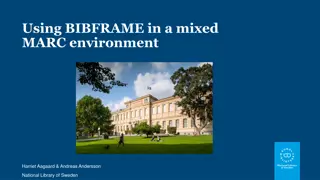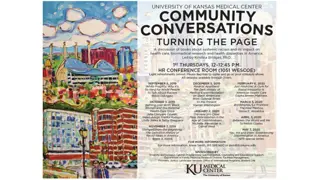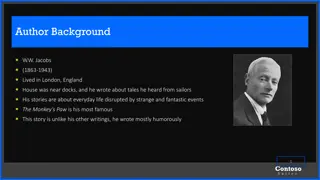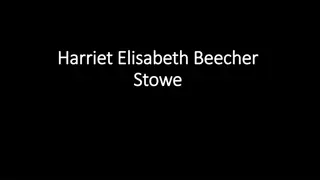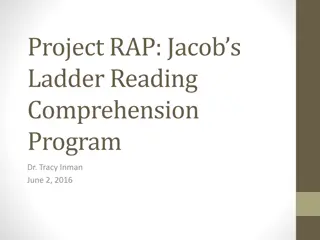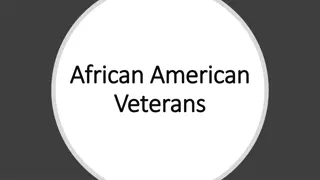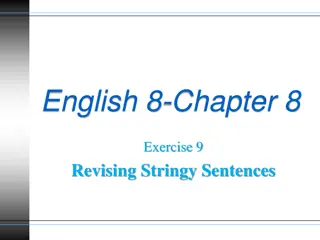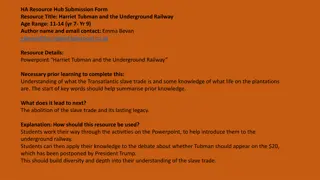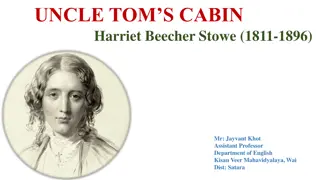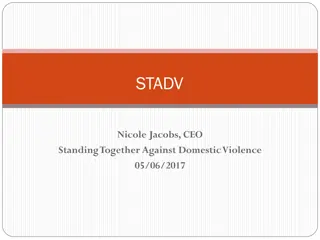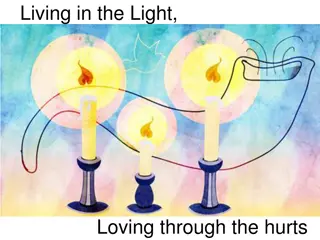
Literature of Liberation: Harriet Jacobs and Native American Women in English Studies
Explore the impactful works of Harriet Jacobs and the declarations of Native American women in an English Studies class, delving into the literature of liberation in the United States. Dr. Julia Haba-Osca leads the discussion on literary education, political positioning, and transformative literary experiences.
Download Presentation

Please find below an Image/Link to download the presentation.
The content on the website is provided AS IS for your information and personal use only. It may not be sold, licensed, or shared on other websites without obtaining consent from the author. If you encounter any issues during the download, it is possible that the publisher has removed the file from their server.
You are allowed to download the files provided on this website for personal or commercial use, subject to the condition that they are used lawfully. All files are the property of their respective owners.
The content on the website is provided AS IS for your information and personal use only. It may not be sold, licensed, or shared on other websites without obtaining consent from the author.
E N D
Presentation Transcript
LITERATURA LIBERADORA ESTADOUNIDENSE: LAS LECTURAS DE HARRIET JACOBS Y LAS DECLARACIONES DE MUJERES NATIVAS AMERICANAS EN CLASE DEL GRADO EN ESTUDIOS INGLESES DRA. JULIA HABA-OSCA IPRODES/Dept. FilologiaAnglesa i Alemanya Universitat de Val ncia
DRA. JULIA HABA OSCA Dept. de Filologia Anglesa i Alemanya Licenciada en Filolog a Inglesa y Licenciada en Filolog a Italiana Beca de Naciones Unidas en Tr Vinh University (Vietnam) Bienestar social, cooperaci n y desarrollo local (Dept. Sociologia i Antropologia Social Tesis doctoral en Magisterio: Taller de Poes a en el rea de ingl s como lengua extranjera: hacia el desarrollo de las Competencias Literaria, Intercultural y Comunicativa Premio Extraordinario de Tesis Doctoral: implantaci n de la Educaci n para el Desarrollo Sostenible Mam de un ni o de 4 a os y de una beb de 1 a o
ESTADO DE LA CUESTIN 1. C mo se imparte literatura de Estados Unidos en la Facultat de Filologia, Traducci i Comunicaci de la Universitat de Val ncia Incidents in the life of a Slave Girl (1861) de Harriet Jacobs 2. Qu posicionamiento pol tico tenemos desde nuestro mbito filol gico ante el uso de la literatura; 3. Cu les son los enfoques, los procesos y las pr cticas de la educaci n literaria para generar experiencias alternativas transformadoras
LITERATURA DE EEUU I: DE LOS OR GENES AL SIGLO XIX Grado en Estudios Ingleses Asignatura obligatoria; primer semestre en 2 2020-2021: 47 estudiantes This course is an overview of the origins of the literature of the United States as reflected in the work and the lives of the most relevant authors of the early colonial period and its further development in the 18thand 19th centuries, with particular attention to the various religious, political and cultural phenomena that have produced the contemporary American character
CONTENIDOS ACADMICOS 1. Colonial Period and Puritanism 2. Enlightenment and Revolution 3. The Nascent Republic 4. Resistance, Romanticism and Rapprochement
HARRIET JACOBS [CIRCA 1815 1897] African-American writer Born into slavery in Edenton (North Carolina), sexually master. harassed by her When he threatened to sell her children, she hid in a tiny crawlspace under the roof at her grandmother s house, where she wasn t even able to stand. After 7 years she escaped.
NEW YORK OR POST-SLAVERY LIFE In New York,she reunited with her children Joseph and Louisa Matilda and her brother John S.Jacobs. She worked as a nanny for Nathaniel Parker Willis children and got into contact with abolitionist and feminist reformers. Her autobiography Incidents in the Life of a Slave Girl (1861) is considered an American classic. Immediately after the Civil War, she went to the Union-occupied parts of the South with her daughter and found two schools for fugitive and freed slaves.
INCIDENTS IN THE LIFE OF A SLAVE GIRL, WRITTEN BY HERSELF Published in 1861 by L.Maria Child,who edited the book for its author. Jacobs used the pseudonym Linda Brent. The book documents Jacob s life as a slave and how she gained freedom for herself and her children. Jacobs contributed to the genre of slave narrative. She explores the struggles and sexual abuse that female slaves faced as well as their efforts to practice motherhood and protect their children when they might be sold away.
ACTIVITY 1: CAN YOU GUESS THE TARGET AUDIENCE OF THIS BOOK?
TOPICS Jacobs women who fail to comprehend the evils of slavery. addresses White Northern Direct appeals to humanity to expand their knowledge thoughts about slavery as an institution. and influence their
CHARACTER LIST Linda Brent Harriet Jacobs, the narrator and protagonist. Dr. Flint Dr. James Norcom, Linda s master, enemy and would-be lover. Aunt Martha Molly Horniblow, Linda s maternal grandmother. Mrs. Flint Mary Norcom, Linda s mistress and Dr. Flint s wife. Benjamin Martha s youngest child and Linda s uncle. Joseph Horniblow, Aunt Emily Flint Mary Matilda Norcom, Dr. Flint s daughter. William John S. Jacobs, Linda s brother, to whom she is close. Mr. Sands Samuel Tredwell Sawyer, father of Linda s children. Benny Joseph Jacobs,Linda s son. Mr. Bruce Nathaniel Parker Willis. Ellen daughter. Louisa Matilda Jacobs, Linda s Mrs. Bruce Cornelia GrinnelWillis.
OVERVIEW CHAPTERS 1 TO 9 Chapters 1 and 2: describe the narrator s childhood and story of her grandmother until she got her freedom. Chapter 3:describes the hiring out and selling of slaves on NewYear s Day. Chapter s 4 to 7: tell the narrator s story: longing for her uncle s Benjamin brother William and her freedom. Benjamin s escape, Dr. Flint s sexual harassment,his wife s jealousy,and the lover who she is forbidden to marry. Chapter 8:What Slaves AreTaught toThink of the North Chapter 9:gives varios examples of cruel treatment of slaves
OVERVIEW CHAPTERS 10 TO 30 Chapters 10 and 11:affair with Mr.Sands and first child s birth. Chapter 12:narrator s experience of anti-black violence. Chapter 13:The Church and Slavery. Chapters 14 to 21: birth of second child, her removal from the town to Flint s plantation,her flight and her concealment in her grandmother s garret. Chapters 22 to 28: seven years spent in that narrow place, the escape of her brother William, the plans made for the children and the cruel treatment and death of her aunt Nancy. Chapters 29 and 30:her dramatic scape to Philadelphia.
OVERVIEW CHAPTERS 31 TO 41 Chapters 31 to 36: her short stay in Philadelphia, her reunion with her children, her new job as a nanny; her flight to Boston when she is threatened with recapture by Flint and northern racism. Chapter 37:her journey to England with Mr.Bruce and his baby Mary. Chapters 38 to 41: renewed threats of recapture (Fugitive Slave Law), her confession of affair with Mr.Sands to her daughter,her stay with Isaac and Amy Post in Rochester, the final attempt of her legal owner to capture her, her legal freedom and grandmother s death.
ACTIVITY 3: WHAT DO YOU THINK THE GARRET MEANS?
KATHERINE MCKITTRICK LITERARY CRITIC In analyzing the hiding place of Harriet Jacobs (Linda Brent) the space of her grandmother's garret - McKittrick illuminates the tensions that exist within this space and how it occupies contradictory positions. Not only is the space of the garret one of resistance and freedom for Brent, but it is also a space of confinement and concealment. That is, the garret operates as a prison and,simultaneously,as a space of liberation. For Brent, freedom in the garret takes the form of loss of speech, movement, and consciousness. McKittrick writes, "Brent's spatial options are painful; the garret serves as a disturbing, but meaningful, response to slavery." In these sense, the space of the garret is both one of captivity and protection for Brent.
THEMES 1. Resistance 2. Pro-slavery propaganda and cruel reality 3. Church and Slavery
RESISTANCE Fight against brutal masters. Two slaves who dare to resist their master s physically: her uncle Joseph ( Benjamin ) who throws him on the ground when he attempts to whip him and runs away to avoid public whipping; and her brother John ( William ) who fights when he is trying to whip him and wins. Jacob s uncle is caught, paraded in chains through Edenton and put in jail, where his health suffers so much that he is sold for a lower price. Women slaves resist by running away. Harriet Jacobs knew how to fight back with words: not following pattern of submissive behavior.
PRO-SLAVERY PROPAGANDA AND CRUEL REALITY Jacobs includes a chapter about the death and funeral of her aunt Betty (called Nancy in the book); i.e.: Northern travelers... might have described this tribute of respect to the humble dead as... a touching proof of the attachment between slaveholders and their servants , but adding that the slaves might have told that imaginative traveler a different story. The funeral had not been paid for by aunt Betty's owner, but by her brother, Jacobs's uncle Mark (called Philipp in the book), and Jacobs herself could neither say farewell to her dying aunt nor attend the funeral, because she would have been immediately returned to her tormentor.
CHURCH AND SLAVERY Her grandmother teaches her grandchildren to accept their status as slaves as God s will and her prayers are mentioned in several points of the story; i.e.: I only wants to read dis book, dat I may know how to live, den I hab no fear bout dying . Jacobs also tells that during her stay in England in 1845/1846 she found her way back to the religion of her upbringing. However,she is very critical regarding the religion of the slaveholders: there is a great difference between Christianity and religion at the south .
REIVINDICACIONES DE LAS MUJERES IND GENAS EN LA ACTUALIDAD Di logo y Diferencia: Retos feministas a la globalizaci n (2008) Tomado de los Labios: G nero y Eros en Mesoam rica (2011) Mujeres, Ind genas, Rebeldes, Zapatistas (2011) Mujeres ind genas y cosmovisi n descolonial (2014) Otro mundo otro camino feminista (2015)
EDUCACIN EMANCIPADORA Y LITERATURA LIBERADORA 1. Orientaci n cr tica y un firme compromiso con la praxis transformadora; 2. Proponen metodolog as participadas y dise adas por el conjunto de personas y grupos 3. Se definen como proceso colectivo para que las comunidades reconozcan y sientan que forman parte de la transformaci n estructural 4. Impulsan miradas que cuestionan los modelos educativos imperantes y las futuras posibilidades que nos brinda la literatura abri ndose a nuevos paradigmas.
ACCIN TRANSFORMADORA Divisi n del estudiantado en 4 grupos 1. LA INDIVIDUALIDAD CUESTIONADA 2. EL LENGUAJE DIAL GICO DE LAS MUJERES NO CAUC SICAS FRENTE AL FEMINISMO 3. LA PERSPECTIVA DE G NERO DESDE LAVISI N DE LAS MUJERESAFROAMERICANAS E IND GENAS 4. LA RE-SEMANTIZACI N DE LA ESPIRITUALIDAD
LA INDIVIDUALIDAD NO CUESTIONADA READER, be assured this narrative is no fiction. I am aware that some of my adventures may seem incredible; but they are, nevertheless, strictly true. I have not exaggerated the wrongs inflicted by Slavery; on the contrary, my descriptions fall far short of the facts. Mantenemos que el avance de los derechos humanos de las mujeres ind genas est ligado inextricablemente a la lucha para proteger, respetar y lograr [el cumplimento de] los derechos de nuestros pueblos como un todo, y nuestros derechos como mujeres adentro de nuestras comunicades a nivel nacional e internacional
EL LENGUAJE DIALGICO DE LAS MUJERES NO CAUC SICAS FRENTE AL FEMINISMO Reader, my story ends with freedom: not in the usuay way, with marriage. I and my children are now free! We are as free from the power of slave holders as are the white people of the north; and though that, according to my ideas, is not saying a great deal, it is a vast improvement in my condition En estos ltimos cinco a os, nos ha tocado esclarecernos entre nosotras mismas. Tener la seguridad que luchar por nuestros pueblos tambi n pasa por contribuir a disminuir las diferencias y privilegios entre los miembros de la comunidad ind gena, hacer que nuestros l deres varones entiendan que hay que retomar el equilibrio en las relaciones entre todos nosotros, y que hablar y trabajar para mejorar las propias capacidades de las mujeres ind genas no significa dividir la organizaci n, como muchas veces se nos ha dicho, sino m s mutuamente y hacer unidad de la lucha colectiva bien fortalecernos
LA PERSPECTIVA DE GNERO DESDE LA VISI N DE LAS MUJERES AFROAMERICANAS E IND GENAS Slavery is terrible for men but it is far more terrible for women. Superadded to the burden common to all, they have wrongs, and sufferings, and mortifications peculiarly their own Tambi n le queremos decir a los hombres que nos respeten nuestro derecho como mujer [ ] Pero no lo vamos a pedir de favor, sino que lo vamos a obligar a los hombres uqe nos respeten. Porque muchas veces el maltrato que recibimos las mujeres no s lo lo hace el rico explotador [ ] Entonces, decimos claro que, cuando exigimos respeto a las mujeres, no solo lo demandamos de los neoliberales, tambi n se lo vamos a obligar a los que luchan contra el neoliberalismo y dicen que son revolucionarios, pero en su casa no [ ] Es importante pasar del discurso a la pr ctica de nuestros valores cosmog nicos, desde lo personal, lo familiar, lo comunitario y en nuestras organizaciones
LA RE-SEMANTIZACIN DE LA ESPIRITUALIDAD ? Estamos pr cticas ancestrales y la espiritualidad de nuestros pueblos [ ] Estamos promoviendo un desarrollo con identidad basado en la cosmovisi n de los pueblos ind genas [ ] Respeto a los lugares administraci n de los mismos desde nuestros pueblos; Rescatamos la cosmovisi n ind gena de los pueblos para espiritualidad y la cultura. recuperando y fortaleciendo las sagrados y la mantener viva la
CONCLUSIONES Que las mujeres ind genas formamos parte importante en el desarrollo de nuestro pueblo y del pa s; Que los derechos de las mujeres y en particular de las mujeres ind genas no son reconocidos por la Constituci n -; Que el derecho a la paridad y la equidad es parte de las exigencias que presentamos en la Mesa de Derechos y Cultura Ind gena; Que queremos cambiar el art culo 27 constitucional para que permita que las mujeres tengamos derecho a heredar la tierra

